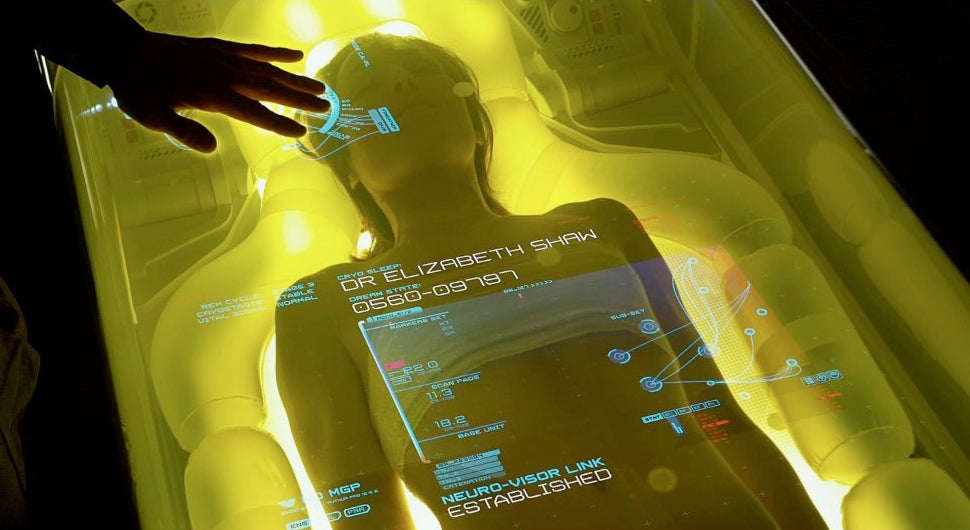What this Suspended animation is ?
Literally speaking Suspended animation is the slowing or stopping of life processes by exogenous or endogenous means without termination. or some far slowing down aging process. It is truly SCIENCE FICTION concept which you have witnessed in the movies like Prometheus & even star trek
It's like another method of CRYONICS i.e way of Life-Preservation But difference is that In CRYONICS organism are preserved in Liquid Nitrogen until they get reanimation this is not way in Suspended Animation

This "Suspended Animation" is now not far topic of Sci-Fiction As it has turn into Reality by Surgeons from the UPMC Presbyterian Hospital in Pittsburgh, Pennsylvania,
The researchers behind it don't want to call it suspended animation, but it's the most conventional way to explain it.
The world's first humans trials will start at the UPMC Presbyterian Hospital in Pittsburgh, with 10 patients whose injuries would otherwise be fatal to operate on. A team of surgeons will remove the patient's blood, replacing it with a chilled saline solution that would cool the body, slowing down bodily functions and delaying death from blood loss.
"According to Dr. Samuel Tisherman, talking to New
Scientist: "We are suspending life, but we don't like to
call it suspended animation because it sounds like
science fiction... we call it emergency preservation and
resuscitation."
Literally speaking Suspended animation is the slowing or stopping of life processes by exogenous or endogenous means without termination. or some far slowing down aging process. It is truly SCIENCE FICTION concept which you have witnessed in the movies like Prometheus & even star trek
It's like another method of CRYONICS i.e way of Life-Preservation But difference is that In CRYONICS organism are preserved in Liquid Nitrogen until they get reanimation this is not way in Suspended Animation

This "Suspended Animation" is now not far topic of Sci-Fiction As it has turn into Reality by Surgeons from the UPMC Presbyterian Hospital in Pittsburgh, Pennsylvania,
The researchers behind it don't want to call it suspended animation, but it's the most conventional way to explain it.
"According to Dr. Samuel Tisherman, talking to New
Scientist: "We are suspending life, but we don't like to
call it suspended animation because it sounds like
science fiction... we call it emergency preservation and
resuscitation."
Surgeons from the UPMC Presbyterian Hospital in Pittsburgh, Pennsylvania, are set to begin suspended animation trials by dramatically cooling down trauma victims in an effort to keep them alive during critical operations.
Twenty years ago, Peter Safar and Ron Bellamy proposed that the rapid induction of hypothermia could "buy time" for a trauma surgical team to control bleeding. Now, thanks to the work of Peter Rhee and Samuel Tisherman, this idea is officially ready for prime time.
EPR-CAT
"We are suspending life, but we don't like to call it suspended animation because it sounds like science fiction," noted Tisherman in a New Scientist article. "So we call it emergency preservation and resuscitation." The idea is to buy patients precious time during critical operations, such as after a massive heart attack, stabbings, or shootings.
The technique will be used on 10 patients who would otherwise be expected to die from their injuries. The doctors on the project will be paged when a candidate patient arrives at the hospital; there's usually one case like this every month, typically with survival rates less than 7%.
It's part a feasibility and safety study, called the Emergency Preservation and Resuscitation for Cardiac Arrest from Trauma (EPR-CAT).
Because patients cannot give informed consent, the study will be conducted under the exception-from-informed consent process, which includes community consultation and public notification. So, if you live in the Pittsburgh area, and this seems too risky for you, you have to opt out (which you can do here).
How It Works
This technique involves internal rather than external cooling. A team of surgeons will remove all of the patient's blood, replacing it with a cold saline solution; the cold fluid is administered through a large tube, called a cannula, which is placed into the aorta, the largest artery in the body. This will slow down the body's metabolic functions, significantly reducing its need for oxygen. Then, a heart-lung bypass machine will be used to restore blood circulation and oxygenation as part of the resuscitation process. A state of profound hypothermia will be induced, at about 50ºF (10ºC), to provide a "prolonged period of cardiac arrest" after extensive bleeding. In other words, clinical death.
The technique, which was developed by Peter Rhee, was successfully tested on pigs back in 2000 (his resulting study can be found here). Writing in C|Net, Michelle Starr explains more:
After inducing fatal wounds in the pigs by cutting their arteries with scalpels, the team replaced the pigs' blood with saline, which lowered their body temperature to 10 degrees Celsius.
All of the control pigs, whose body temperature was left alone, died. The pigs who were resuscitated at a medium speed demonstrated a 90 percent survival rate, although some of their hearts had to be given a jump start. Afterwards, the pigs demonstrated no physical or cognitive impairment.
The technique, therefore, will only be used as an emergency measure on patients who have suffered cardiac arrest after severe traumatic injury, with their chest cavity open and having lost at least half their blood already — injuries that see only a seven percent survival rate. The survival rate of these patients will then be measured against a control group that has not received the treatment before further testing can begin.
The human body can only be placed in this state for a few hours, so we're still quite a ways off from the suspended animation typically featured in scifi. But if this technique is any indication, we may get there just yet.
Source: io9
You may also enjoy
No comments:
Post a Comment